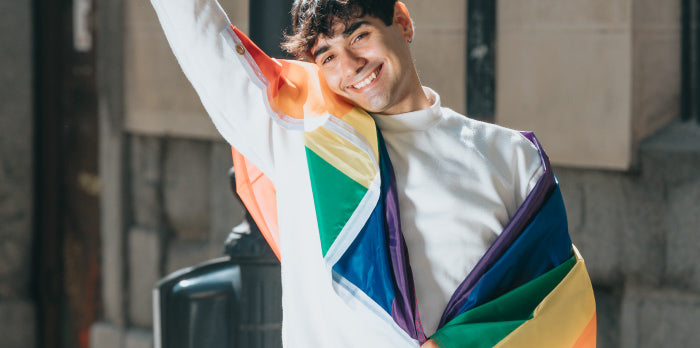
Male Biphobia: Why Men Are the Most Invisible
|
|
Time to read 3 min
|
|
Time to read 3 min
Fortunately, over the years and thanks to the strength of social movements LGBTIQ+ rights have made significant progress. However, it’s clear that not every letter in the acronym has advanced equally. Male bisexuality, in particular, continues to face multiple forms of erasure and stigma . But why only male bisexuality?
Unlike bisexual women—whose orientation is often associated with hypersexualization or seen as mere experimentation— bisexual men are frequently dismissed, suspected of being secretly gay, or labeled as confused . As harsh as it may sound, it’s a reality. That’s why in this article, we explore why male biphobia remains so deeply rooted and how it impacts mental health, identity and relationships.
Biphobia is defined as rejection, mistrust or discrimination toward bisexual people . It can come from both heterosexual environments and from within the LGTBIQ+ community itself. In the case of men, this discrimination takes on specific nuances: they’re often accused of being “in a phase,” of “not having come out yet,” or of wanting to keep their heterosexual privileges while still being attracted to other men.
Bisexual men also face constant pressure to define themselves clearly , as if their orientation had to fit into a binary framework (in other words, it must be either “black or white”). This results in bisexual men questioning their masculinity, being constantly invalidated, and receiving less representation in media, campaigns, and research related to sexual diversity. So, what’s really behind all of this?
Let’s start with the most obvious point: there are very few representations of male bisexuality in film, television or literature. And when they do exist, they are often highly stereotyped. While bisexual female characters are usually portrayed through an eroticized lens, bisexual men are barely given space in cultural narratives and when they are, they’re often associated with betrayal, promiscuity or a lack of commitment.
This absence of real, positive role models reinforces the idea that male bisexuality is unstable or doesn’t truly exist. As a result, many bisexual men choose to hide their orientation , label themselves as gay or straight depending on their current partner, or even suppress their desires out of fear of rejection.
Although limited, some studies, such as Ross et al. (2010), have shown that bisexual men report higher levels of anxiety, depression and feelings of isolation than either gay or heterosexual men. The lack of acceptance from both heterosexual and gay communities creates a double layer of discrimination that deeply affects psychological wellbeing.
We also can’t ignore the impact of internalized biphobia (negative beliefs bisexual people may hold about themselves or others) which can lead to denial of their identity, unhealthy relationships and greater difficulty forming genuine emotional bonds. The feeling of not being “gay enough” or “straight enough” undermines self-esteem and makes it harder to develop a strong, free sexual identity.
Male biphobia cannot be fully understood without talking about toxic masculinity . Bisexuality in men challenges the traditional model of masculinity, which links being a man with heterosexuality, dominance and certainty. A man who expresses desire for other men, even if he also desires women, calls this narrative into question.
As a result, many bisexual men experience symbolic or verbal violence from other men who feel their masculine identity is being threatened. This violence isn’t always overt: it often shows up in jokes, erasure, silence or exclusion that reinforce heterosexuality as the only legitimate option . That’s why many bisexual men choose to express and live out only their heterosexual side as a form of self-protection.
The solution lies in giving greater visibility to bisexual men, creating safe spaces where they can share their experiences and promoting sex education that recognizes bisexuality as a valid orientation in its own right. It's also essential for the LGBTIQ+ community itself to examine and challenge biphobic attitudes, and to build genuine alliances, not just symbolic.
Celebrating male bisexuality means breaking away from binary thinking, acknowledging the diversity of desire and questioning the imposed norms about what a man's sexual identity should be. Only then can we build a society that is truly diverse, inclusive, and free.
Ross, L. E., Dobinson, C., & Eady, A. (2010). Perceived determinants of mental health for bisexual people: a qualitative examination. American journal of public health, 100(3), 496–502. https://doi.org/10.2105/AJPH.2008.156307
Ochs, R. (1996). Biphobia: It goes more than two ways. In B. A. Firestein (Ed.), Bisexuality: The psychology and politics of an invisible minority (pp. 217–239). Sage Publications, Inc.
Yoshino, K. (2000). The Epistemic Contract of Bisexual Erasure. Stanford Law Review, 52(2), 353–461.
Callis, A. S. (2013). The Black Sheep of the Pink Flock: Labels, Stigma, and Bisexual Identity. Journal of Bisexuality, 13(1), 82–105. https://doi.org/10.1080/15299716.2013.755730

